A platform for decentralized cryptographic
trade and payment service creation
v
1.1
Latest publication date: Nov. 23 2017
http://www.neonexchange.org
The information in this document is subject to change over time.
It does not constitute any financial advice
�
NEX: a platform for decentralized cryptographic
trade and payment service creation
Ethan Fast, PhD∗
Neon Exchange
Stanford, CA. USA
ethan@neonexchange.org
Fábio C. Canesin, MSc
Neon Exchange
Cambridge, MA. USA
canesin@neonexchange.org
Luciano Engel, Eng
Neon Exchange
Florianópolis, Brazil
luciano@neonexchange.org
Fabian Wahle, PhD
Neon Exchange
Zürich, CH
fabian@neonexchange.org
Thomas Saunders
Neon Exchange
Minneapolis, MN. USA
tom@neonexchange.org
Abstract
Today, cryptocurrencies are primarily traded on centralized exchanges where user
funds are at risk to hackers and platform managers. Decentralized exchanges
(DEXs) allow users to retain control of their funds as trades are mediated by smart
contracts on a blockchain, but on-chain computation is generally too slow to keep
up with high volume order books. This paper describes Neon Exchange (NEX),
a new decentralized exchange on the NEO blockchain that applies a publicly
verifiable off-chain matching engine to handle massive trading volume and support
complex orders (such as limit orders) that are not possible on existing DEXs. NEX
also introduces a payment service and funds management layer that enables third-
party smart contracts on NEO to send and receive global assets as part of their
computation. To fund developments and future expansion into related services,
NEX will issue 50 million tokens that give holders a share of profits in its services.
1 Introduction
Cryptocurrency markets have grown enormously in recent years, from a daily trade volume of $60
million in January of 2015 to more than $8 billion in November of 2017 [1]. Despite the fact that
most cryptocurrencies are secured by decentralized architectures, almost all trades between currencies
take place on centralized exchanges, where funds must be deposited under the control of the entity
facilitating exchange. This layer of centralization puts user funds at risk to hackers and platform
managers. Most famously, millions of dollars worth of Bitcoin were stolen from Mt. Gox in 2011,
and again from Bitfinex in 2016 [27, 20].
Recently, decentralized exchanges have emerged to allow users to trade without giving up control
of their funds [26, 2]. Under these systems, trades are executed by smart contracts on a blockchain,
removing the need for a centralized third-party to control user accounts. While these exchanges
succeed at their primary goal of decreasing third-party risk, their success comes at the cost of a huge
loss of trading performance. Smart contracts are far too slow to execute the complex matching logic
of order books on high-volume, centralized exchanges. In practice, this means that users cannot
execute complex trades, and presents opportunities for arbitrage on stale orders [11].
If centralized exchanges provide speed, and decentralized exchanges provide security, then it seems
natural to ask: can a hybrid system provide the best of both worlds? In this paper, we propose that
∗Computer Science PhD to be granted in May 2018 by Stanford University
Version 1.1. Copyright of Neon Exchange, 2017
�
the optimal mix of speed and security is provided by a decentralized exchange with a fully off-chain
matching engine. Order matching is by far the most computationally expensive operation when
running an exchange. By encapsulating this component in a trusted off-chain service, we can reap
enormous improvements in speed, and also support complex orders such as limits or margins. At
the same time, by committing orders on-chain as they are matched—with provable deterministic
behavior—we can retain the security benefits of traditional decentralized exchanges.
Neon Exchange (NEX) is a new decentralized exchange that embodies these ideas, built on the NEO
blockchain. This white paper presents our vision for the NEX platform, the performance benefits
of our technical approach, and how NEX fits into the broader NEO ecosystem. We also discuss our
roadmap over the coming months and plans for a public token sale.
2 Background
2.1 Blockchain and Smart Contracts
A blockchain is a decentralized ledger that can record transactions between two parties in a verifiable
and permanent way without the need for a central authority [24]. In 2008, Bitcoin emerged as the first
public blockchain with large-scale adoption as a digital currency. Other chains have since attempted
to improve on this technology. Most notably, Ethereum launched in 2015 as the first blockchain
with programmable, Turing complete smart contracts [28]. Smart contracts allow developers to
publish programs on a blockchain that anyone can inspect, and that will deterministically execute
to accomplish complex goals in a way verifiable to all involved third parties. For example, a smart
contract might accept incoming funds from a user, then release them at a certain date, or collect funds
from a series of users and split them evenly. These smart contracts are what make possible more
sophisticated distributed on-chain applications such as decentralized exchanges.
2.2 Decentralized Exchanges
Many decentralized exchanges have emerged over the years. In this section, we lay out the trade-offs
in this design space, and how NEX contributes over existing systems. In summary, NEX trades a
small degree of user trust for vastly improved performance and usability.
The earliest decentralized exchanges placed order books directly on the blockchain [4, 3]. In these
systems, market makers must perform on-chain transactions every time they want to place, modify, or
cancel an order. Further, as new orders are placed, a smart contract must execute matching logic that
runs slowly (and redundantly) on all virtual machines in the network. In general, these exchanges
take up a large amount of network bandwidth and operate very slowly, so very few decentralized
exchanges operate under this scheme today.
A second class of systems uses automated market maker (AMM) smart contracts, as opposed to an
on-chain order book [22, 23]. These systems adopt a price adjustment model, where all parties trade
with the AMM, and the spot price of an asset is determined by the resulting market forces. While
AMMs provide increased availability and performance over on-chain order books, they are still much
slower than centralized exchanges and must place artificial constraints on supply to prevent their
working capital from being depleted by potential arbitragers.
State channels have been proposed to reduce network overhead for the more general problem of asset
exchange [21, 6], allowing two parties to iterate on a transfer off-chain before ultimately committing
to it on-chain. However, state channels are expensive to open and close, usually requiring a security
deposit and a series of on-chain transactions. For this reason, they are most useful among known
parties who want to manage a series of interactions (e.g., a “bar tab”), not a single party conducting
one transaction with a broader market.
Building from state channels, a more recent class of DEX is based on off-chain relay [26, 2]. In
these systems, market makers broadcast an order off-chain, which can then be picked up by an
interested counterparty and passed to a smart contract for fulfillment. These systems require far
fewer on-chain transactions to perform a trade, but still suffer from performance issues in comparison
to centralized exchanges. Notably, order matching is not automatic in these systems, presenting
arbitrage opportunities against users who are slow to cancel their orders. Similarly, the absence of
matching means that users cannot place more complex orders such as limit buys or market sells.
2
�
In contrast to these approaches, we introduce a new kind of decentralized exchange, NEX, based on a
trusted, off-chain matching engine [5]. This matching engine works exactly like its equivalent in a
centralized exchange, but only has control over active orders, and commits trades on-chain without
access to the full balance of a user account. Like exchanges based on off-chain relay, NEX orders are
matched off-chain and fulfilled on-chain, but NEX’s automatic matching engine reduces opportunities
for arbitrage and allows for more complex orders. To ensure trust, NEX provides a public record of
orders and a deterministic specification of behavior, so that users can verify orders matched off-chain
and claim an award in the event of incorrect behavior. Taken together, this makes NEX the first
decentralized exchange with performance comparable to today’s centralized exchanges.
2.3 The NEO Blockchain
NEO was launched in 2015 as China’s first public blockchain. Recent improvements to the network
have made it a compelling alternative to Ethereum for smart contracts and distributed applications
[29]. NEX will run first on NEO, before later expanding to support exchange on Ethereum. While
most of the ideas behind NEX apply to both platforms, there are several major differences between
NEO and Ethereum that are relevant to decentralized exchanges.
2.3.1 Modeling User Balance
Ethereum is based on an account model, where a user’s balance of ETH is stored as a number in
the Ethereum Virtual Machine (EVM) and can be easily modified (e.g., sent or received by smart
contract logic) [12]. In contrast, global assets in NEO such as NEO and GAS are based on a UTXO
model, where funds are sent and received through a chain of spent transaction ids on the network [10].
Notably, these differences only apply to global assets on the NEO network and not tokens created
through smart contracts, which behave similarly to ETH [13].
Each system design has trade-offs. In Ethereum, for example, it is easy for a smart contract to interact
with a user’s balance of ETH, but difficult for a node to prove that a transaction has taken place
without syncing the full chain and running the EVM. In contrast, it is easy for third parties in NEO to
verify that a transaction has taken place on the chain (e.g., through SPV [9]), but much more difficult
for smart contracts to program interactions with a user’s NEO or GAS balance.
For NEX to succeed, smart contracts on NEO require some way to programmatically interact with
global assets like NEO and GAS. To solve this problem, we introduce a novel payment service layer,
that converts global assets into smart contract tokens, which can then be easily interacted with by
smart contracts on the NEO network. Users can convert their global assets into tokens by depositing
them at the payment service address, then later withdraw them from that contract address (perhaps
with a different balance), whenever their interactions with a third-party smart contract have been
completed. We believe this solution will generalize to other networks that combine UTXO models
with independent smart contracts, such as Cardano [7].
2.3.2 Calls Between Smart Contracts
A second major difference between NEO and Ethereum is how and when smart contracts are allowed
to call each other in the course of execution. In Ethereum, a smart contract can dynamically call any
other smart contract, given an address passed at run-time. In contrast, NEO enforces that all calls
between smart contracts must be declared statically in advance [14]. This constraint makes it much
easier for NEO to implement sharding optimizations across VM state, but means that NEX smart
contracts must hard-code all token pairs that are supported by the exchange.
2.3.3 Consensus
NEO and Ethereum also operate under very different consensus models. NEO uses delegated
Byzantine Fault Tolerance (dBFT) for consensus [19, 25], whereas Ethereum uses Proof of Work
(PoW) [8]. NEO’s consensus model allows for much higher theoretical transaction throughput (up
to 10,000 tps) which has a huge positive impact on the performance of a decentralized exchange.
As Ethereum moves to a Proof of Stake (PoS) model in 2018, NEO’s comparative advantage may
diminish, but many details have yet to be worked out before that transition occurs [15].
3
�
3 Neon Exchange
Neon Exchange (NEX) aims to combine the performance of centralized exchanges with the trust
and security properties of decentralized exchanges. The system consists of three main components:
an off-chain trade matching engine, a smart contract where trades are executed, and a payment
service where global assets such as NEO and GAS can be converted to tokens that can be transfered
directly by smart contracts, making them compatible with the exchange. In the following sections,
we describe each component in more depth.
3.1 Off-chain Matching Engine
An off-chain matching engine allows NEX to benefit from the performance characteristics of cen-
tralized exchanges, while maintaining a decentralized user account model based on the blockchain
(Figure 1). Orders are signed and sent from user addresses to the matching engine, where they are
quickly and deterministically processed using high-performance hardware. Matched orders are then
signed off-chain and committed back to user accounts on the blockchain.
Figure 1: The NEX architecture provides fast, decentralized exchange using an off-chain matching
engine. Here we illustrate an example user interaction with NEX exchange. First, one user authorizes
a trade to exchange Token A for Token B (1) and sends the order to the matching engine (2). Next, a
second user authorizes and submits a trade for Token B in exchange for Token A (3-4). The engine
matches the orders (5) and submits them to a smart contract for execution (6). Note that steps (1-2)
and (3-4) can be initiated either via API call or the NEX exchange website.
To trade on NEX, a user must first authorize NEX to access the amount of token to be traded by
calling the NEP-5 approve method on the token’s smart contract. The user can then submit a signed
JSON request to the NEX matching engine API. Once the order is matched off-chain, the engine
will call the NEX smart contract to execute the order. Because a single invocation transaction on
NEO can contain many smart contract calls, the engine can batch a set of matched orders in one
on-chain transaction to minimize computation. Assuming 1,000 transactions per second, NEX could
potentially execute more than 100 thousand trades per second on the chain. In the future, such batches
could adopt match-rings to further enhance liquidity [18].
3.2 Trusted Off-chain Matching
While an off-chain matching engine brings enormous performance benefits, it also opens the door to
potential trust issues between users and the exchange. How do users know that the engine is matching
orders fairly, for example, and not manipulating the order books to its own benefit? To address this
problem, we propose the idea of provable fair off-chain matching. Under this scheme, the off-chain
matching engine follows a publicly specified deterministic algorithm. By combining this knowledge
with a public ledger of the order in which trades have been sent to the exchange and fulfilled on the
blockchain, any user can verify that the exchange is operating fairly. To make this trust in NEX even
more explicit, in the future we plan to build a smart contract where users can submit evidence of
unfair exchange behavior in return for a large reward.
Concretely, matching on NEX occurs deterministically based on price and time, commonly known as
FIFO [16]. Lower priced orders will be matched first, with preference given to orders placed earlier
in time at a given price level. Any modifications to an order will reset its placement time.
4
�
3.3 Centralized User Accounts
The security problems of centralized exchanges are not simply a technical challenge to be overcome,
but also a social consequence of the common user desire to hold assets in exchange accounts. This
desire is largely due to the familiarity of the bank-like user experience provided by these centralized
platforms when managing funds. NEX aims to bring a similar user experience to decentralized
exchange by storing a user’s encrypted private key client-side in a user’s browser. This preserves the
security guarantees of a decentralized account model while allowing users to login into NEX through
a traditional web form that asks for a username and password.
3.4 Types of Orders
Unlike existing decentralized exchanges, which only support point-to-point orders that allow tokens
to be traded at a fixed price, NEX supports more complex trades such as limit and market orders.
Below we describe the types of trades available in NEX (Table 1):
Table 1: Order types supported by NEX
Type
Limit
Market
Margin2 Borrow with leverage to go long or short on a token
Description
Exchange tokens above or below a given price ratio
Exchange one token for another at the current market price
NEX is able to support these complex order types due to the speed and flexibility of its matching
engine, which is not limited by slow computation cycles on the blockchain.
3.5 Exchange API
NEX exposes a public JSON API that third-party applications can use to trade tokens. This API
allows users to place, modify, and cancel orders on the matching engine. Because these transactions
take place off-chain, the NEX API can handle tens of thousands of requests per second, in-line with
popular centralized exchanges [17].
To submit an order to the matching engine, a client must make a JSON request that is signed with the
private key associated with the address placing the order. This ensures that a user cannot submit a
trade on an address they do not control. Before attempting to match an order, the engine will also
verify that the user has granted NEX’s smart contract enough of the asset such that the order can
successfully be executed. If the user has not authorized enough funds, the order will be rejected.
To modify or cancel an order, a user must similarly submit a JSON request signed with the correct
private key. An order will then be canceled or modified if it has not already been matched. If an order
has been partially matched, then only the unmatched portion of the order will be affected.
Table 2: NEX initial fee structure
User 30 days volume Taker fee Maker fee
0%
1%
2.5%
5%
10%
20%
0.25%
0.22%
0.19%
0.19%
0.16%
0.13%
0%
0%
0%
0%
0%
0%
3.6 Fee Structure
NEX follows the maker/taker fee structure common to other exchanges. Market makers who place
new limit orders on the order books will pay no fee, while takers who place an order at market place,
or a limit order below the current market price will pay a small fee (Table 2). Fees will be deducted
2this order type is on our roadmap, to be supported some time after the initial launch
5
�
from the taker in the token denomination of their trade. NEX computes a user’s 30 days moving
average volume using the volume of trades associated with their public key, as a percentage of total
exchange volume.
3.7
Implementation
The NEX off-chain matching engine will be built in Elixir, a functional programming language
designed to build scalable, distributed, and fault-tolerant applications. Elixir builds on top of Erlang,
a language originally intended for development of telecommunication systems, which is now used
by modern web developers to manage the challenges of dealing with high availability. Elixir will
help NEX realize an off-chain matching engine that provides service to users from all over the world,
while functioning continuously and without downtime.
3.8 Smart Contract for Token Exchange
The NEX matching engine communicates with a smart contract that commits trades between users.
This smart contract contains logic powered by the NEP-5 token standard, which allows it hold to user
tokens involved in active trades. Once the matching engine computes a match, it sends this smart
contract all involved user addresses and the types and amounts of tokens to trade between them, and
the contract completes the trade. Calls to this smart contract can be batched in a single invocation
transaction to increase performance and reduce network volume.
3.8.1 Trade Method Signature
The NEX exchange smart contract (SC) accepts two parameters: a string indicating the operation to
be performed and a bytearray containing serialized data for usage in the method. The output of any
call will be returned as a bytearray, with the first byte indicating the success or failure of the call and
any resulting data serialized in the remainder of the bytearray.
The central interface between the off-chain matching engine and the blockchain will be the trade
method of the exchange SC. This method will take the parameters currency_maker, currency_taker,
amount_maker, amount_taker, address_maker, and address_taker. With these data the exchange SC
delegates the trade of each currency to a corresponding SC via the NEP5 transferFrom method. In the
case that the transfer of currency from the maker to taker or vice versa fails, any non-failed transfers
will be reversed and the method will return false, otherwise the method will return true.
3.8.2 Security
To ensure that no third-party can execute a fraudulent trade between users, the trade method of the
exchange smart contract will only accept orders signed by a private key held by the matching engine.
3.8.3 Withdrawal
The NEX smart contract only has access to funds involved in active trades, and not the full balance of
tokens at a user’s address. To retrieve tokens held for an active trade, a user can submit a cancel order
to the NEX matching engine, which will then submit an immediate withdraw order to the exchange
SC, transferring tokens back to the user. Delegating this request through the matching engine ensures
that the engine will not match an order that is no longer backed by user funds.
However, to enhance user trust in NEX, the smart contract also supports a slower direct withdrawal
that requires no communication with the off-chain matching engine. This second withdrawal process
ensures that (1) users can withdraw active trade funds in the event of a broken or compromised
matching engine (2) the matching engine has enough time to notice and cancel orders invalidated
through any direct withdrawal of funds. To withdraw directly, a user first calls a public withdrawal
method on the exchange SC, specifying the token type and amount. Ten blocks later, the user can
then call a complete_withdrawal method, and the tokens will be transfered.
Users can always retrieve funds immediately by submitting an order cancellation to the matching
engine, so we expect that the slower direct withdrawal method will not often be used. It exists simply
to prove that users control any funds involved in active trades.
6
�
3.9 Payment Service
The NEX payment service allows NEO smart contracts to interact with assets that live outside of
the NEO virtual machine. For example, a user might use the payment service to make transactions
across chains, sending ETH to a NEO smart contract that then distributes it among their friends’ NEO
addresses. In the future, the payment service will support assets on other blockchains or non-digital
assets such as USD, serving as a gateway for the trade of off-chain assets on NEX. In the near term,
however, the payment service is designed to provide a similar function for global assets on the NEO
blockchain such as NEO and GAS. More broadly, the payment service provides a starting point for
reasoning about how a decentralized exchange can interact with assets on other chains.
3.9.1 Motivation for NEO and GAS
While it might seem surprising that NEO smart contracts cannot send NEO and GAS directly through
computation, there are good reasons for this involving network scalability (see Section 2.3.1). As
a result, the NEX payment service is necessary for complex interactions—such as decentralized
exchange—between smart contracts and these global assets.
3.9.2
Interacting with the Payment Service
At a high level, the payment service converts global assets such as NEO and GAS into token assets
that can be more easily sent and received by smart contracts (Figure 2). When you deposit NEO
into the payment service, an equivalent amount of XNEO is created for you, which can be sent and
received by smart contracts using the NEP-5 standard. For example, when you then withdraw your
NEO from the payment service, your balance of XNEO is adjusted down accordingly. Any address
that receives XNEO can withdraw the equivalent amount of NEO from the payment service.
Figure 2: NEX’s payment service layer allows NEO smart contracts to interact with UTXO based
global assets such as NEO and GAS. Above, a user deposits NEO in the NEX payment service smart
contract, creating a balance of XNEO that can be transferred between smart contracts (1). The user
authorizes a third-party smart contract to access their XNEO (2a). The user then calls that contract
(2b), which sends some of the XNEO to another user and authorizes a second smart contract to use
the rest (2c). The first smart contract then calls the second smart contract (2d). Finally, the users and
second smart contract withdraw NEO from the payment service, zeroing their XNEO balances (3).
3.9.3 Network-Assisted Global Asset Withdrawal procedure
The NEX payment service is powered by a novel withdrawal procedure we have developed for global
assets on the NEO blockchain. While smart contracts are not able to send NEO or GAS to a user
address directly, they are able to execute logic that decides whether a user is authorized to withdraw a
certain amount of these assets through a normal contract transaction. We use this idea to allow users
to withdraw funds from the NEX payment service.
Concretely, to withdraw assets from the payment service, a user calls the withdrawal method on the
service SC, specifying an unspent TXID, asset type, and the amount to withdraw. The smart contract
checks this information, and if a user is cleared for withdrawal, adds the TXID, output address, and
amount to a white list in VM storage. This white list is consulted in any attempted transfer of funds
from the smart contract. The user can then withdraw the appropriate amount from the smart contract
using a normal contract transaction on the network.
By default, this kind of withdrawal is a two-step process. In the first step, a user registers a TXID and
amount in the system for withdrawal, and in the second step, they perform a contract transaction to
7
�
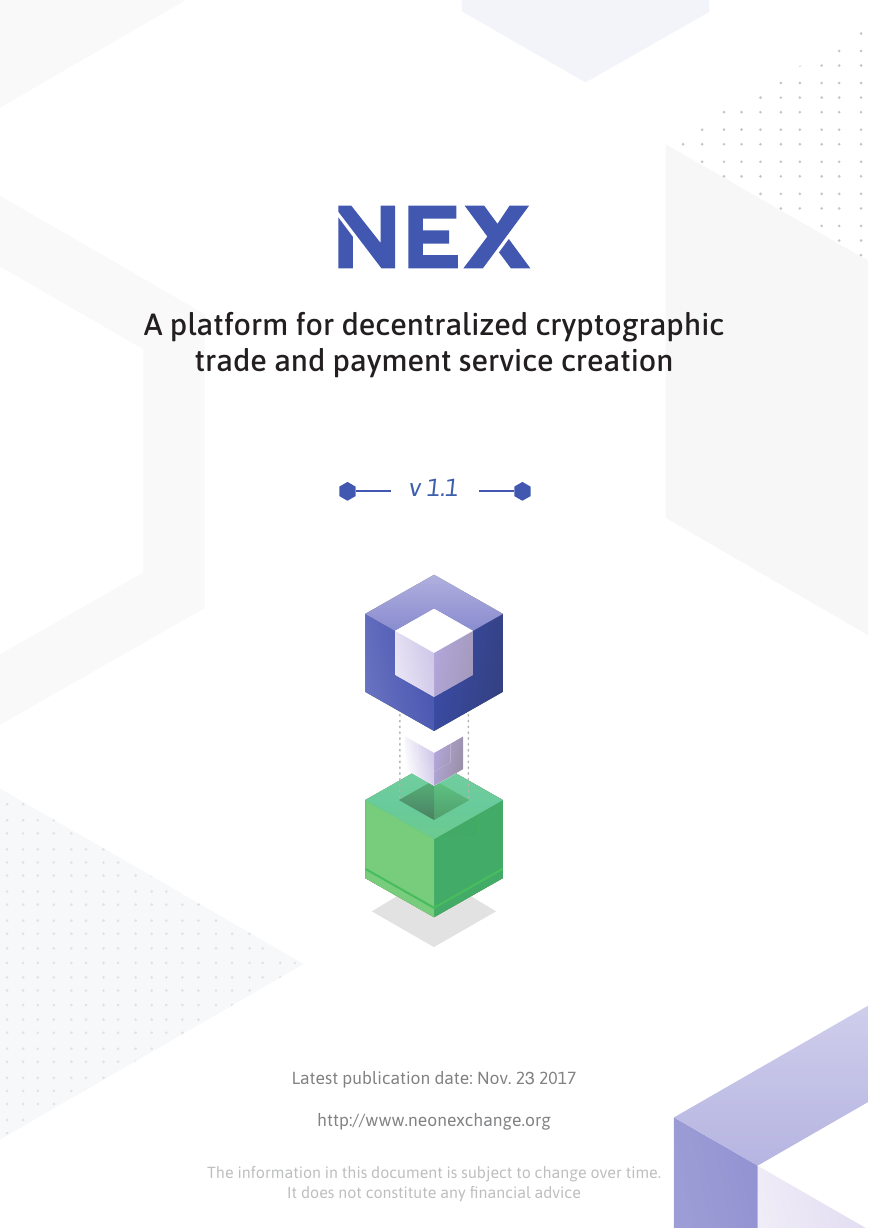
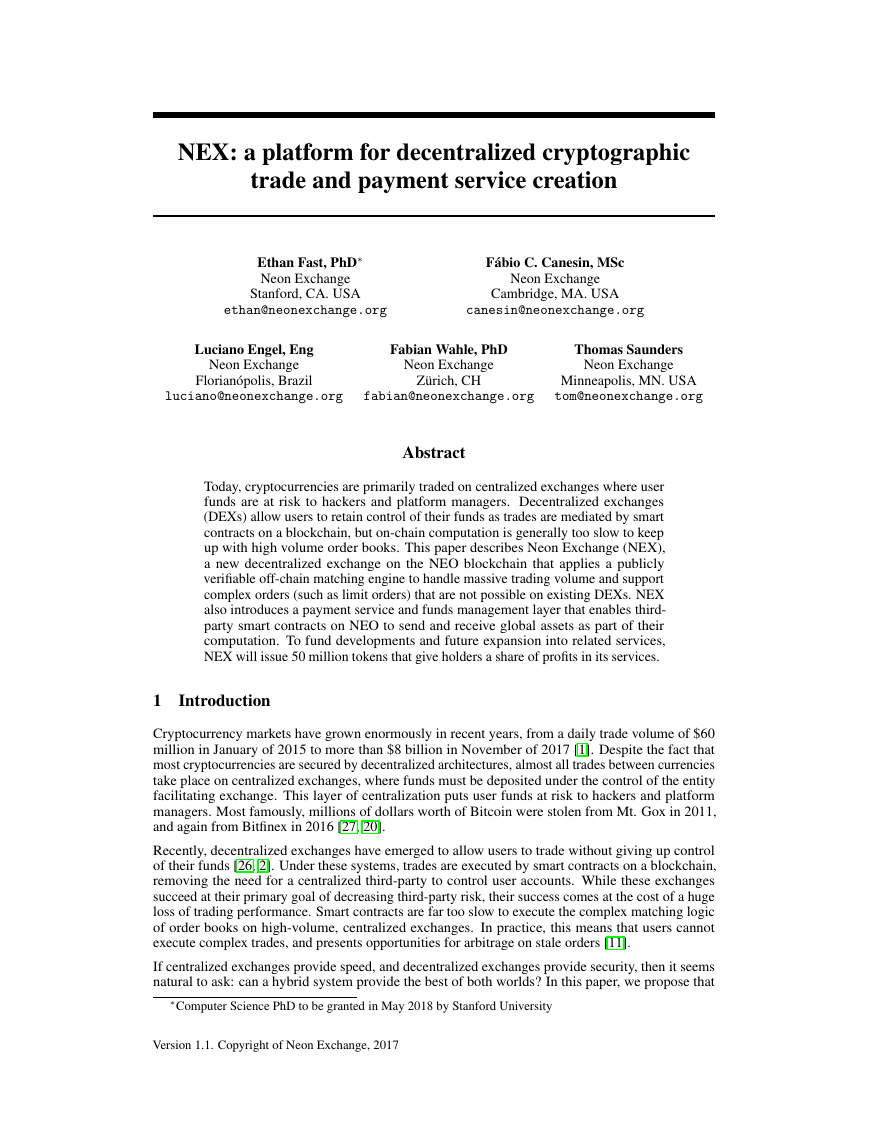
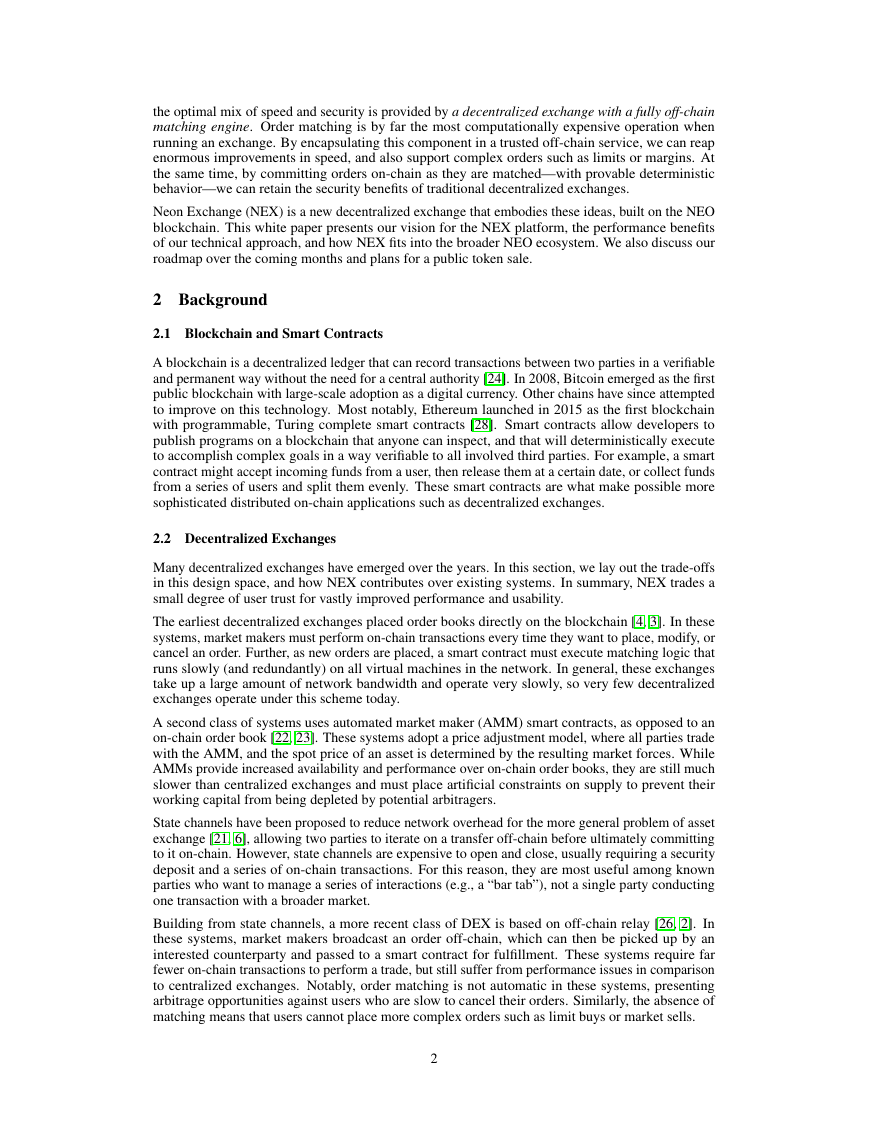
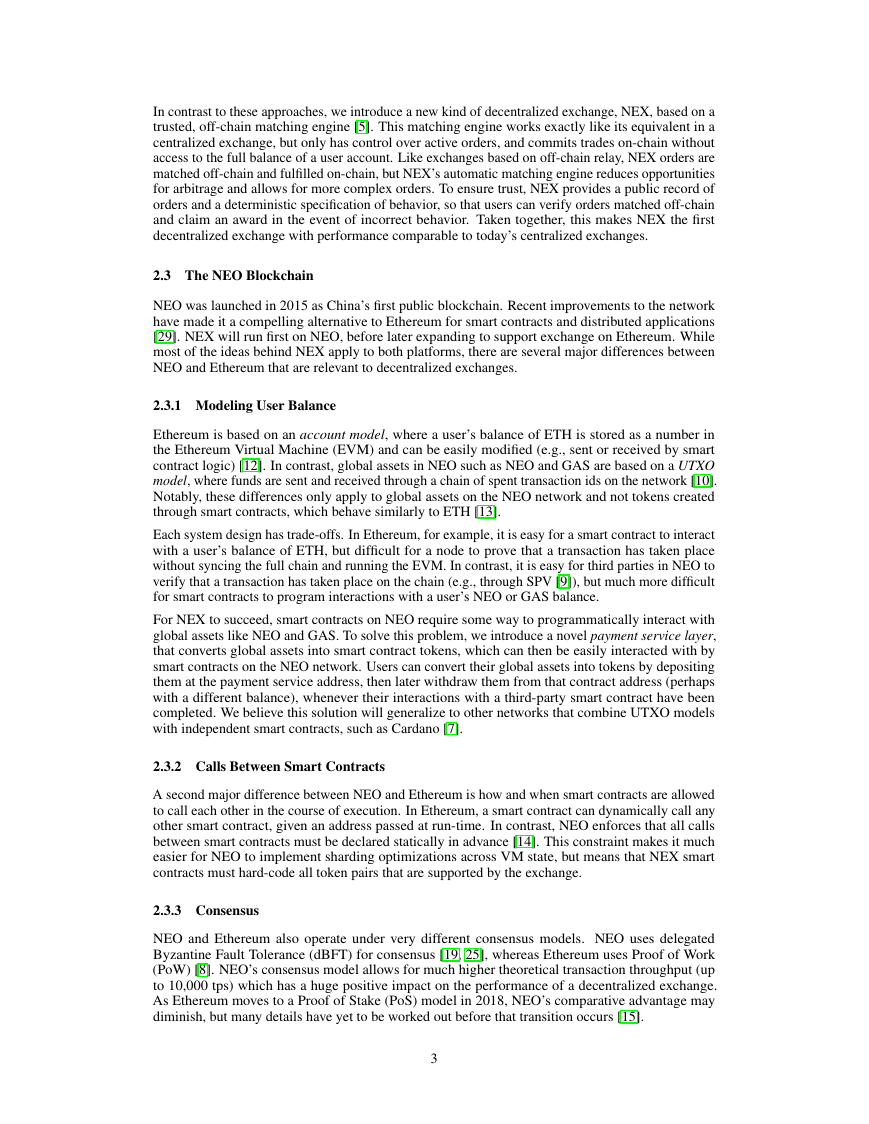

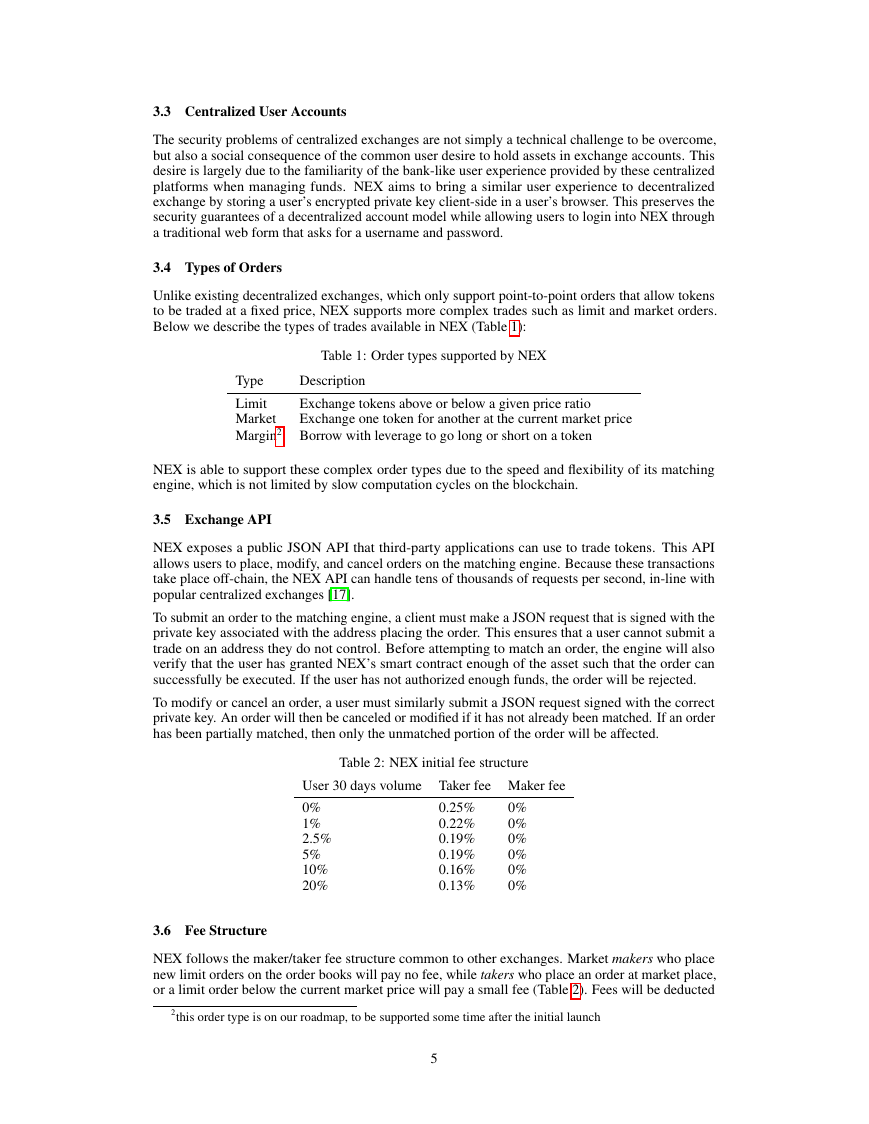
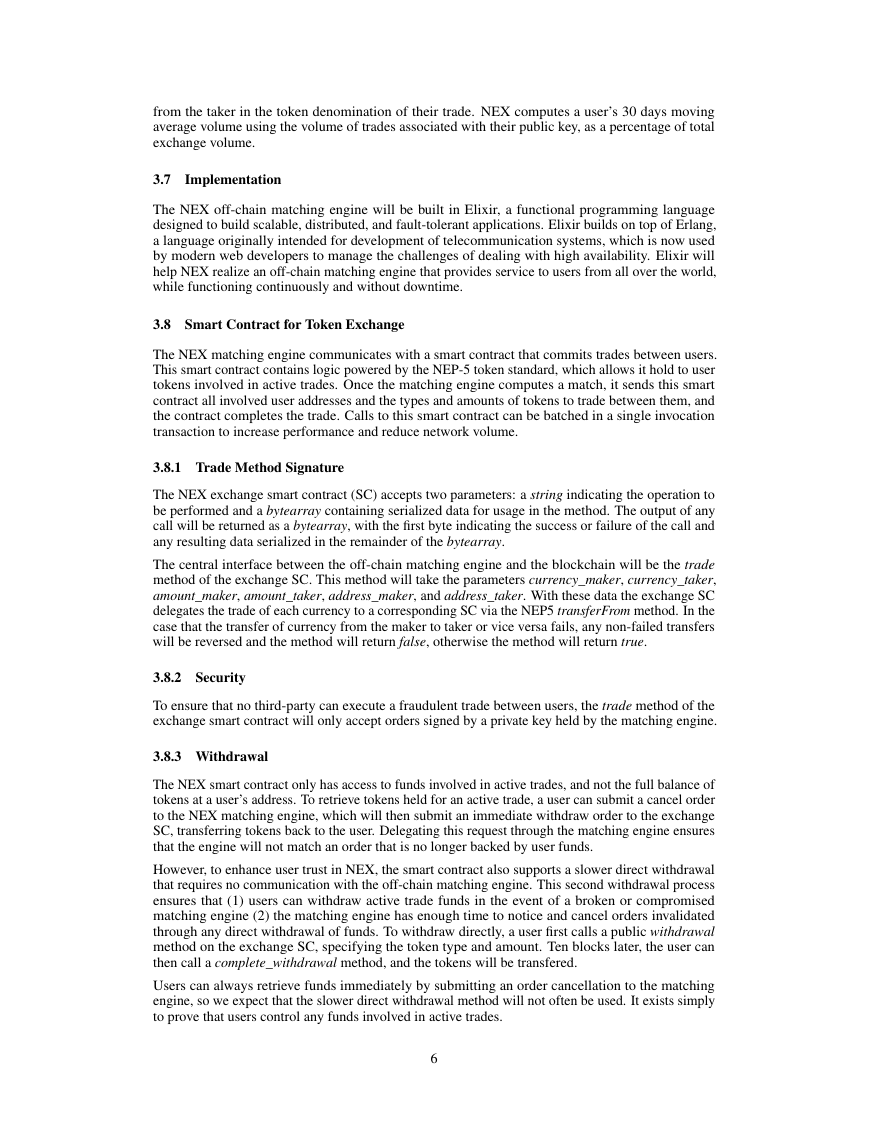
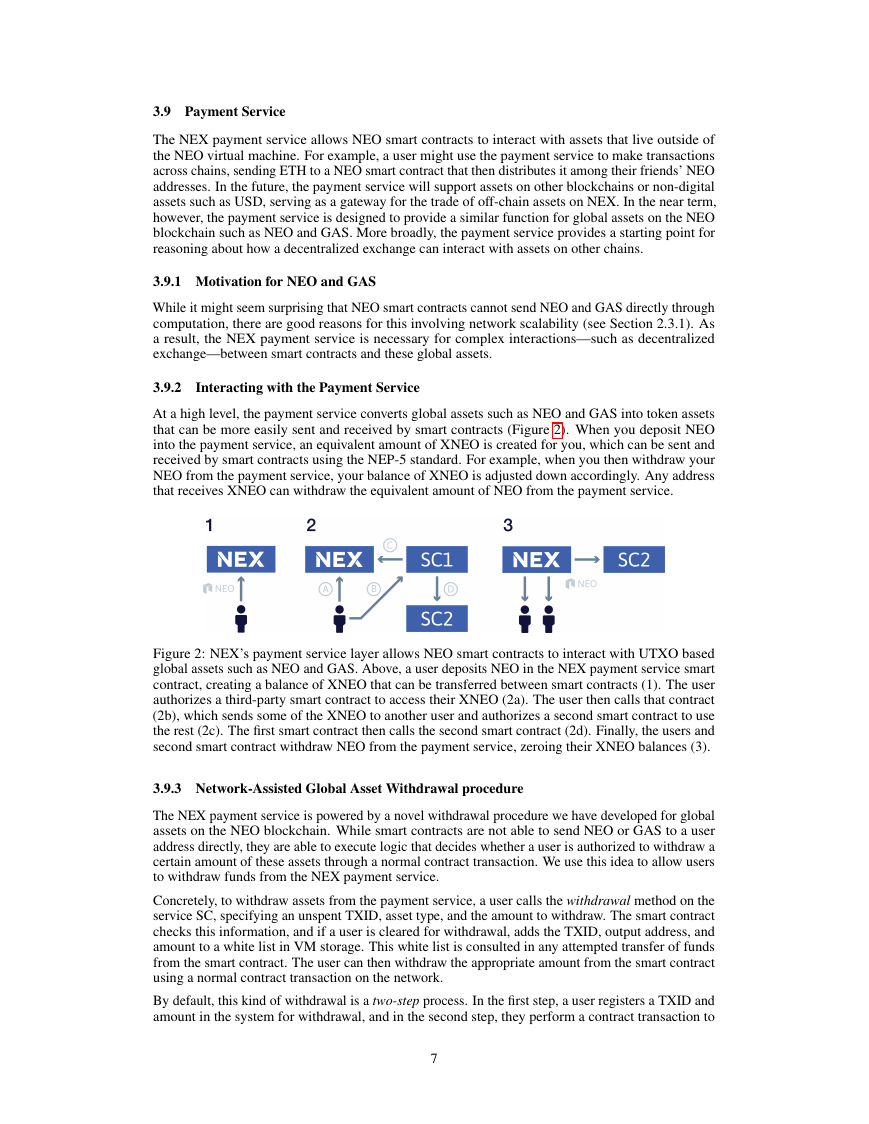








 2023年江西萍乡中考道德与法治真题及答案.doc
2023年江西萍乡中考道德与法治真题及答案.doc 2012年重庆南川中考生物真题及答案.doc
2012年重庆南川中考生物真题及答案.doc 2013年江西师范大学地理学综合及文艺理论基础考研真题.doc
2013年江西师范大学地理学综合及文艺理论基础考研真题.doc 2020年四川甘孜小升初语文真题及答案I卷.doc
2020年四川甘孜小升初语文真题及答案I卷.doc 2020年注册岩土工程师专业基础考试真题及答案.doc
2020年注册岩土工程师专业基础考试真题及答案.doc 2023-2024学年福建省厦门市九年级上学期数学月考试题及答案.doc
2023-2024学年福建省厦门市九年级上学期数学月考试题及答案.doc 2021-2022学年辽宁省沈阳市大东区九年级上学期语文期末试题及答案.doc
2021-2022学年辽宁省沈阳市大东区九年级上学期语文期末试题及答案.doc 2022-2023学年北京东城区初三第一学期物理期末试卷及答案.doc
2022-2023学年北京东城区初三第一学期物理期末试卷及答案.doc 2018上半年江西教师资格初中地理学科知识与教学能力真题及答案.doc
2018上半年江西教师资格初中地理学科知识与教学能力真题及答案.doc 2012年河北国家公务员申论考试真题及答案-省级.doc
2012年河北国家公务员申论考试真题及答案-省级.doc 2020-2021学年江苏省扬州市江都区邵樊片九年级上学期数学第一次质量检测试题及答案.doc
2020-2021学年江苏省扬州市江都区邵樊片九年级上学期数学第一次质量检测试题及答案.doc 2022下半年黑龙江教师资格证中学综合素质真题及答案.doc
2022下半年黑龙江教师资格证中学综合素质真题及答案.doc